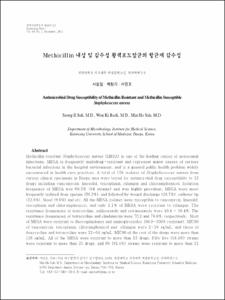Methicillin 내성 및 감수성 황색포도알균의 항균제 감수성
- Keimyung Author(s)
- Suh, Seong Il; Baek, Won Ki; Suh, Min Ho
- Journal Title
- Keimyung Medical Journal
- Issued Date
- 2011
- Volume
- 30
- Issue
- 2
- Keyword
- Antimicrobial susceptibility; Chloramphenicol; Linezolid; Methicillin resistant Staphylococcus aureus (MRSA); Prevalence; Rifampin; Teicoplanin; Vancomycin
- Abstract
- Methicillin resistant Staphylococcus aureus (MRSA) is one of the leading causes of nosocomial
infections. MRSA is frequently multidrug-resistant and represent major causes of serious bacterial infections in the hospital environment, and is a general public health problem widely encountered in health care practices. A total of 156 isolates of Staphylococcus aureus from various clinical specimens in Daegu area were tested for antimicrobial drug susceptibility to 33 drugs including vancomycin, linezolid, teicoplanin, rifampin and chloramphenicol. Isolation frequency of MRSA was 60.3% (94 strains) and was highly prevalent. MRSA were most frequently isolated from sputum (38.3%), and followed by wound discharge (28.7%), catheter tip (12.8%), blood (9.6%) and etc. All the MRSA isolates were susceptible to vancomycin, linezolid, teicoplanin and chloramphenicol, and only 2.1% of MRSA were resistant to rifampin. The resistance frequencies of doxycycline, sulfisoxazole and cotrimoxazole were 40.4 - 56.4%. The resistance frequencies of tetracycline and clindamycin were 70.2 and 76.6%, respectively. Most of MRSA were resistant to fluoroquinolones and aminoglycosides (80.9-100% resistant). MIC90 of vancomycin, teicoplanin, chloramphenicol and rifampin were 2-16 μg/mL, and those of doxycycline and tetracycline were 32-64 μg/mL. MIC90 of the rest of the drugs were more than
128 μg/mL. All of the MRSA were resistant to more than 13 drugs. Fifty five (58.4%) strains were resistant to more than 25 drugs, and 86 (91.4%) strains were resistant to more than 21 drugs. In contrast to the MRSA, most of methicillin sensitive Staphylococcus aureus (MSSA) were susceptible to oxacillin, cefoxitin, cefepime, imipenem, meropenem, vancomycin, linezolid, teicoplanin, chloramphenicol, rifampin, doxycycline, cefazolin, cefaclor, cefotaxime, ceftazidime, ceftizoxime and ceftriaxone. The resistance frequencies of tetracycline, sulfisoxazole and cotrimoxazole were 37.1-54.8%. And the resistance frequencies of fluoroquinolones and aminoglycosides to MSSA were high (71.0-80.6% resistant). In conclusion, this report provides an information on effective drugs for MRSA infections. Continued surveillance activities of MRSA prevalence and antimicrobial resistance patterns both in Korea and in an international setting are essential.
- Alternative Title
- Antimicrobial Drug Susceptibility of Methicillin Resistant and Methicillin Susceptible Staphylococcus aureus
- Publisher
- Keimyung University School of Medicine
- Citation
- 서성일 et al. (2011). Methicillin 내성 및 감수성 황색포도알균의 항균제 감수성. Keimyung Medical Journal, 30(2), 219–231.
- Type
- Article
- 파일 목록
-
-
Download
 30-219.pdf
기타 데이터 / 217.57 kB / Adobe PDF
30-219.pdf
기타 데이터 / 217.57 kB / Adobe PDF
-
Items in Repository are protected by copyright, with all rights reserved, unless otherwise indicated.